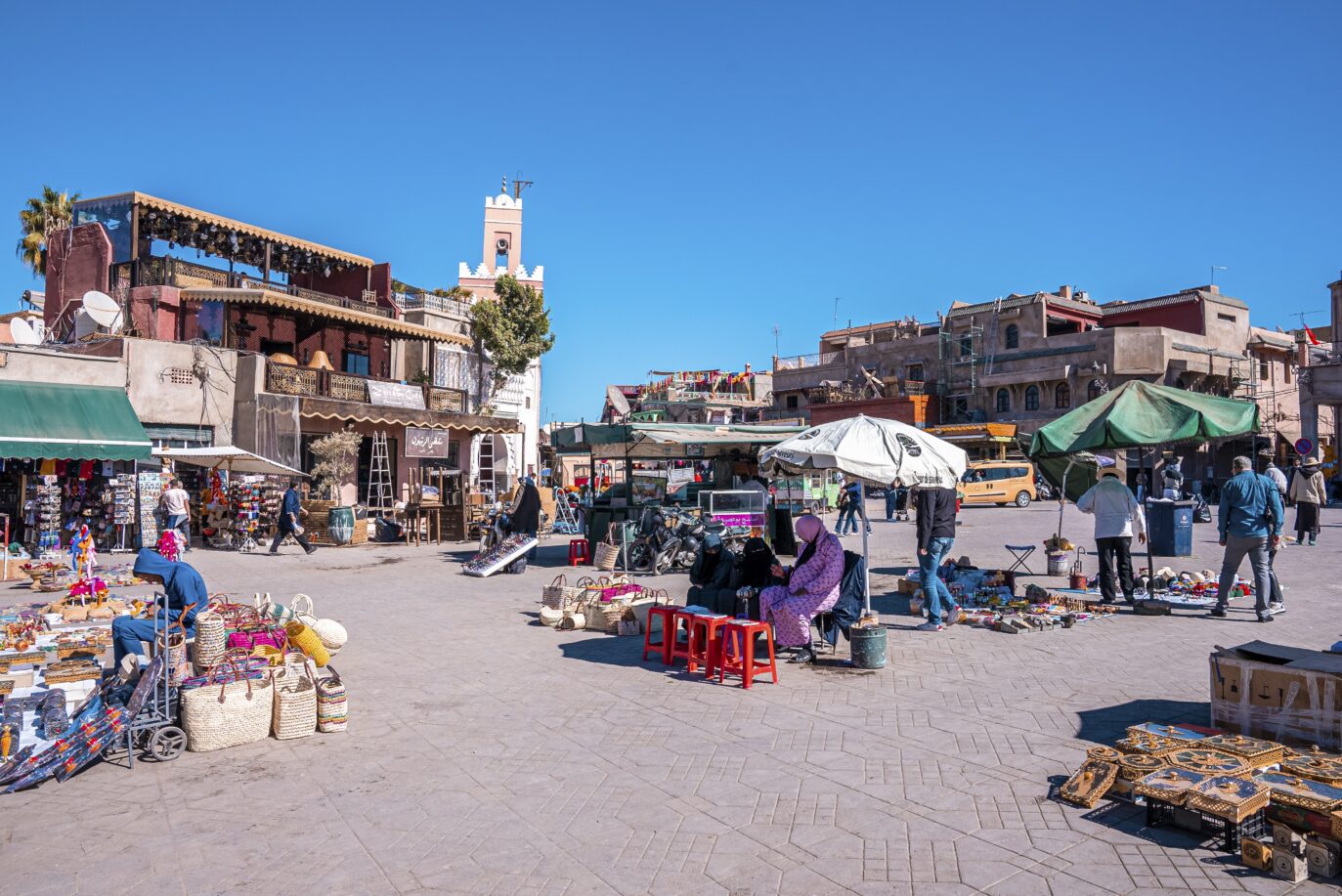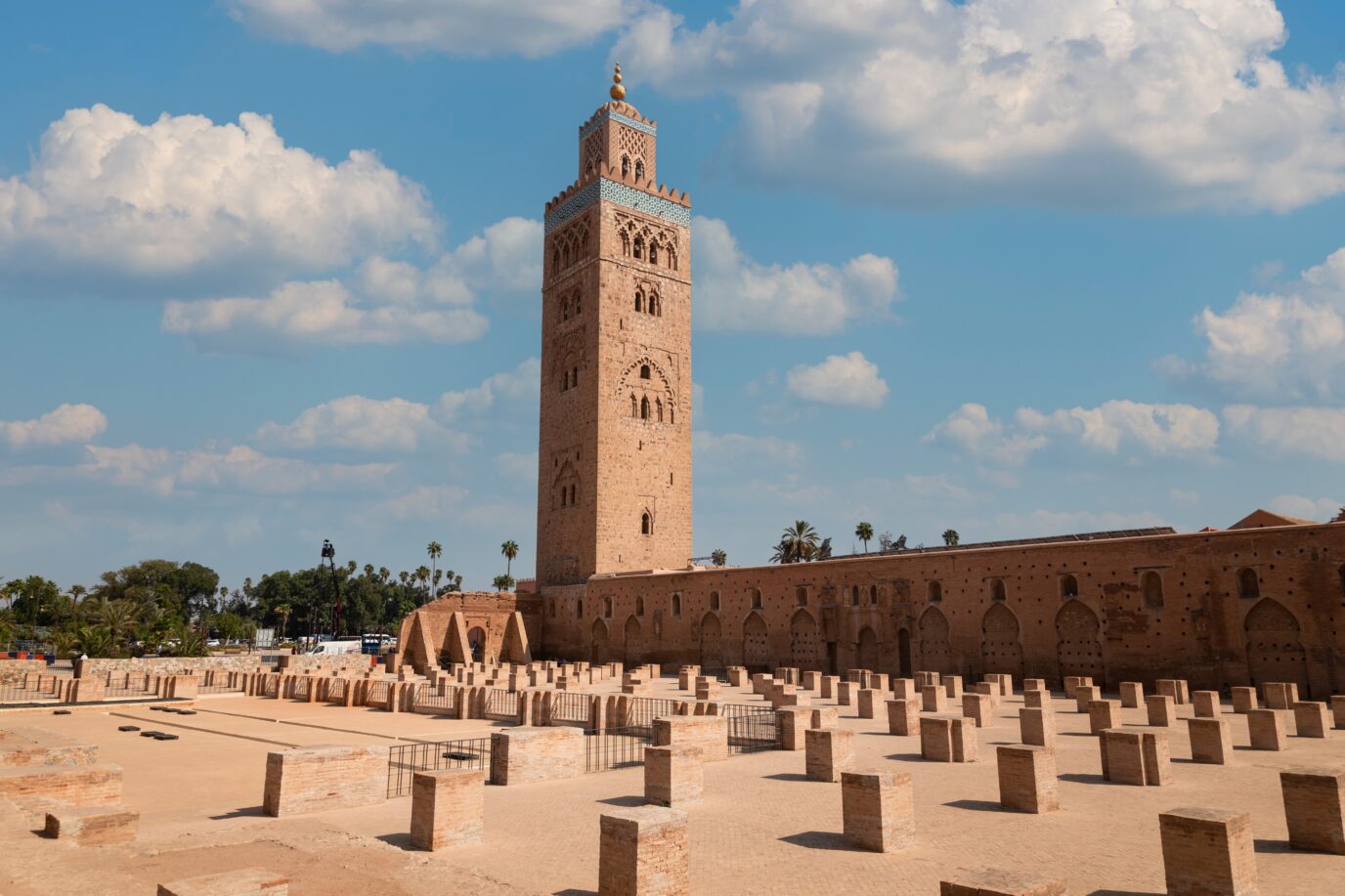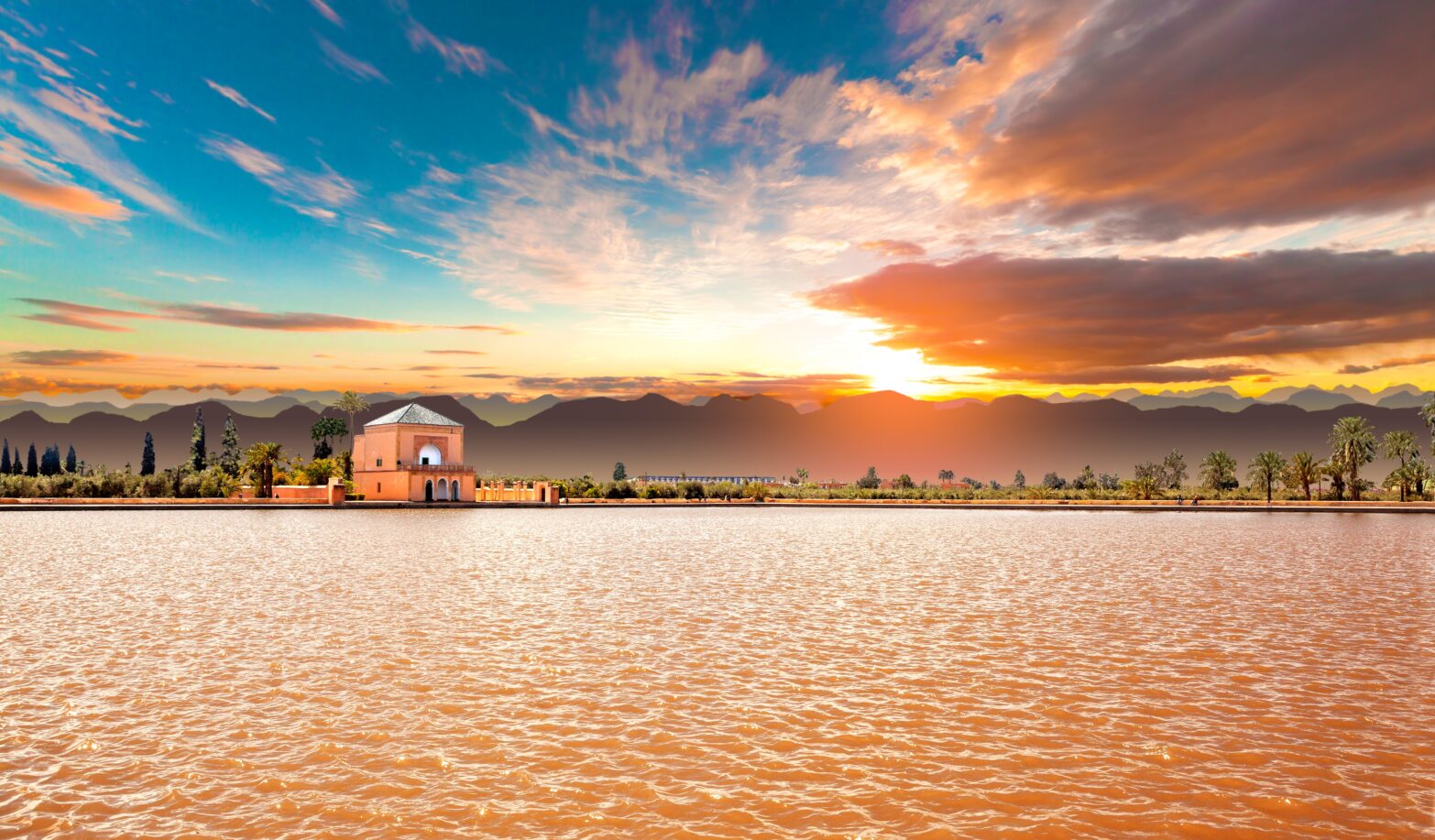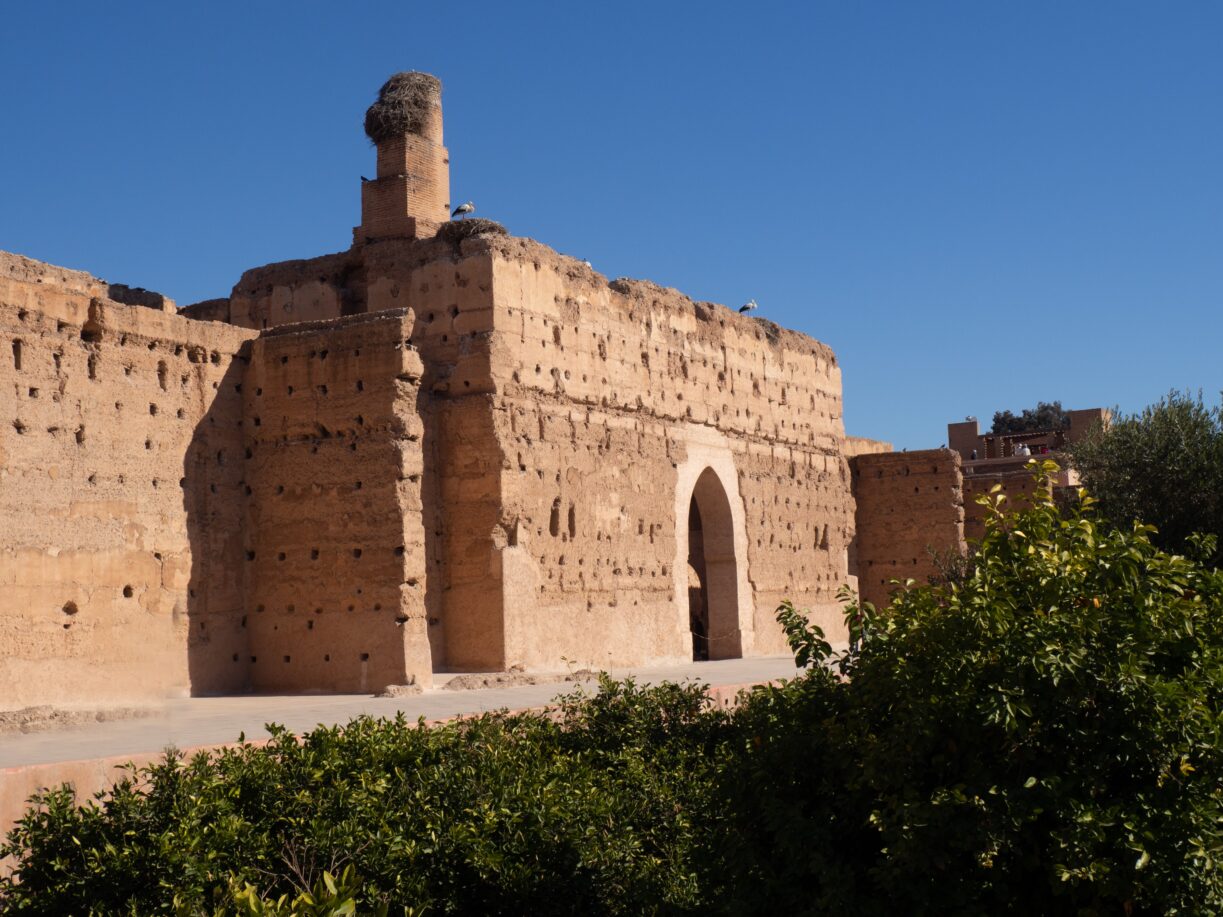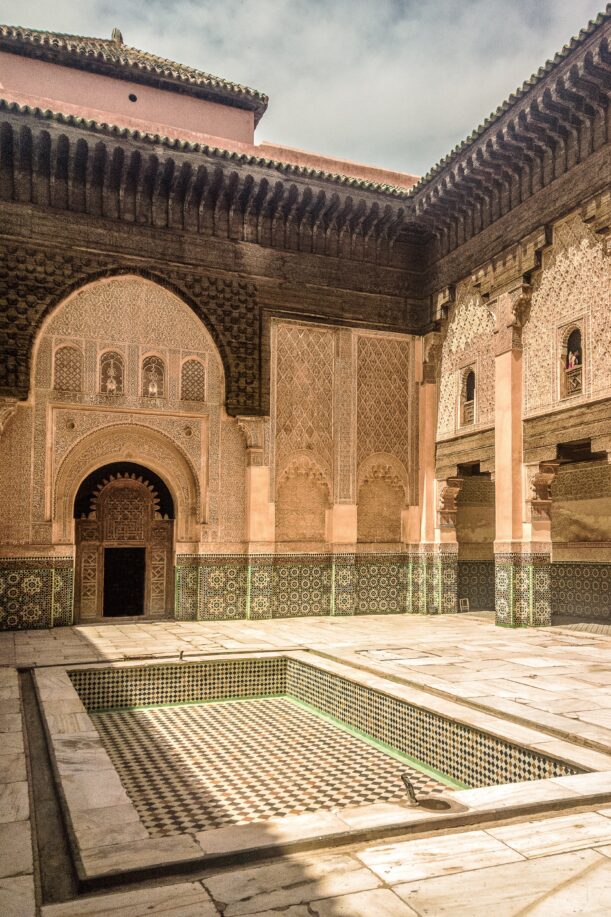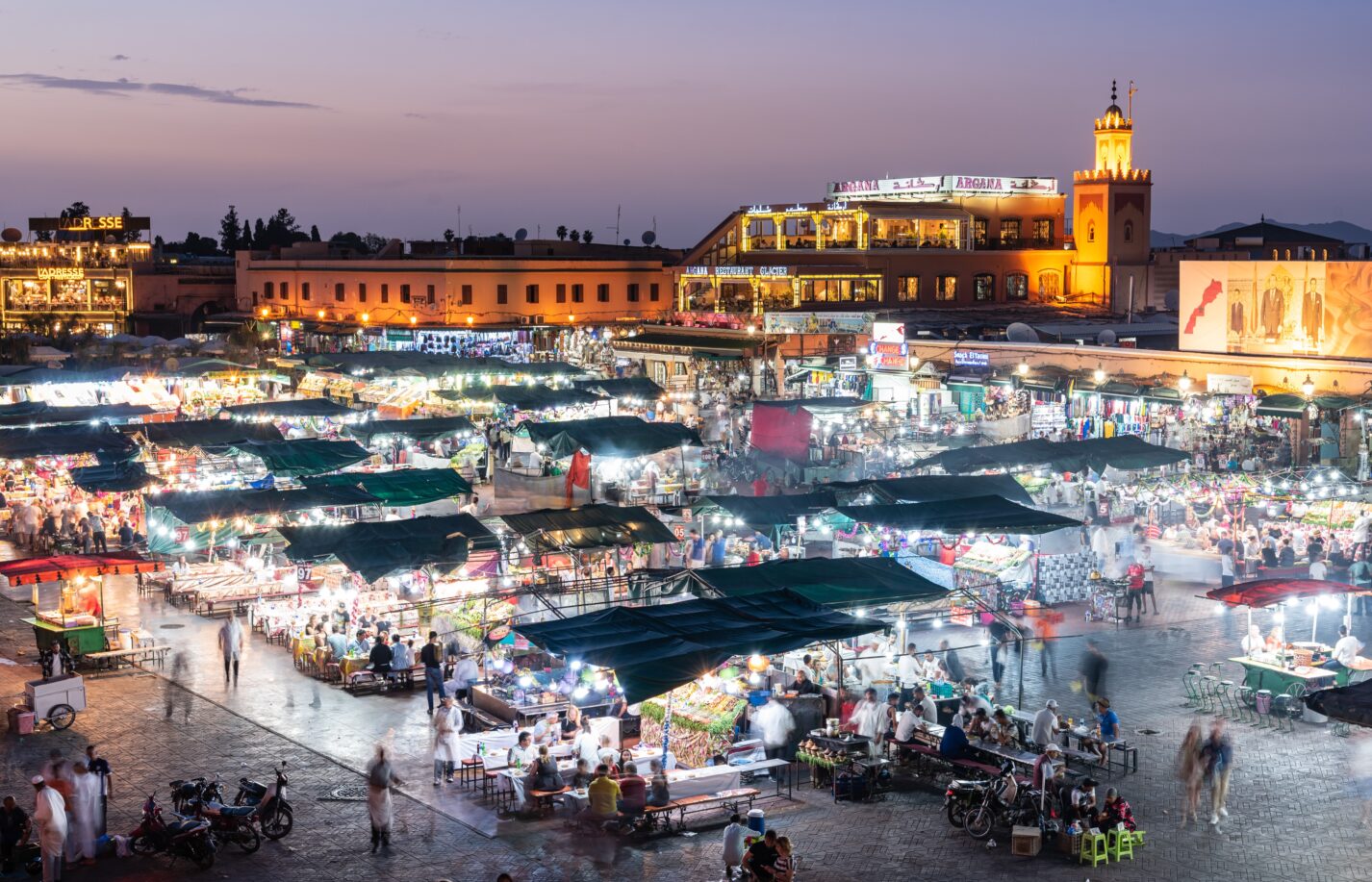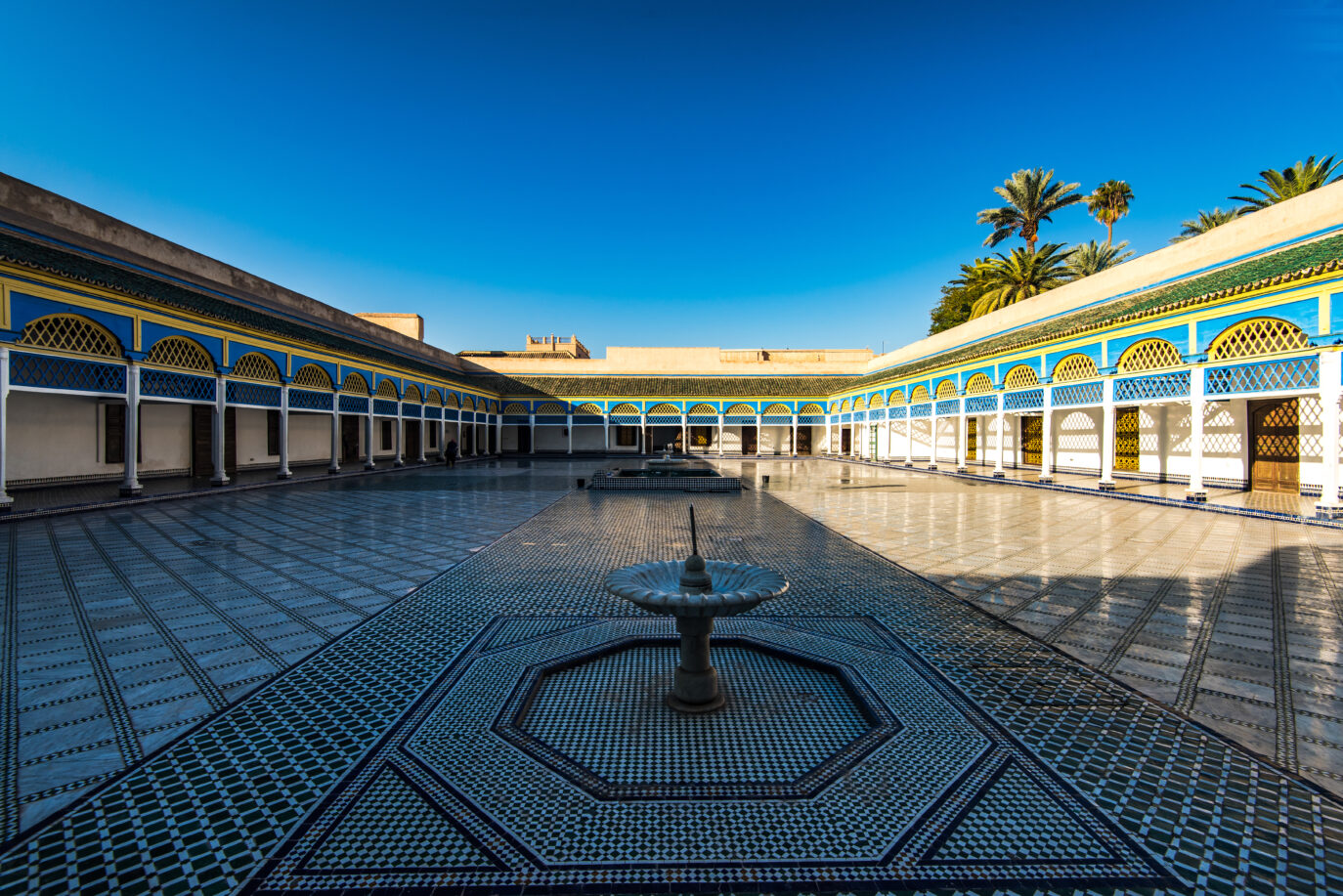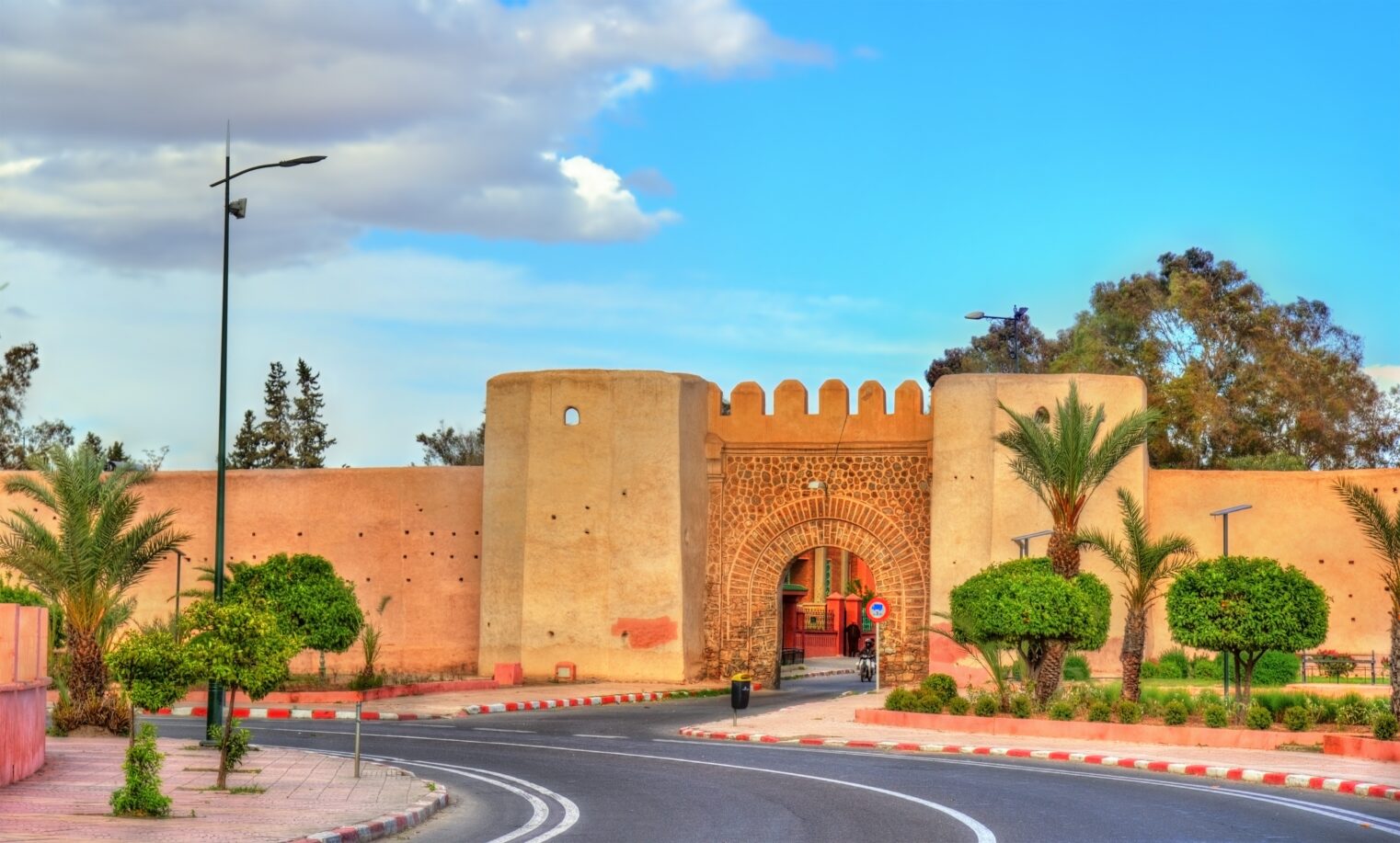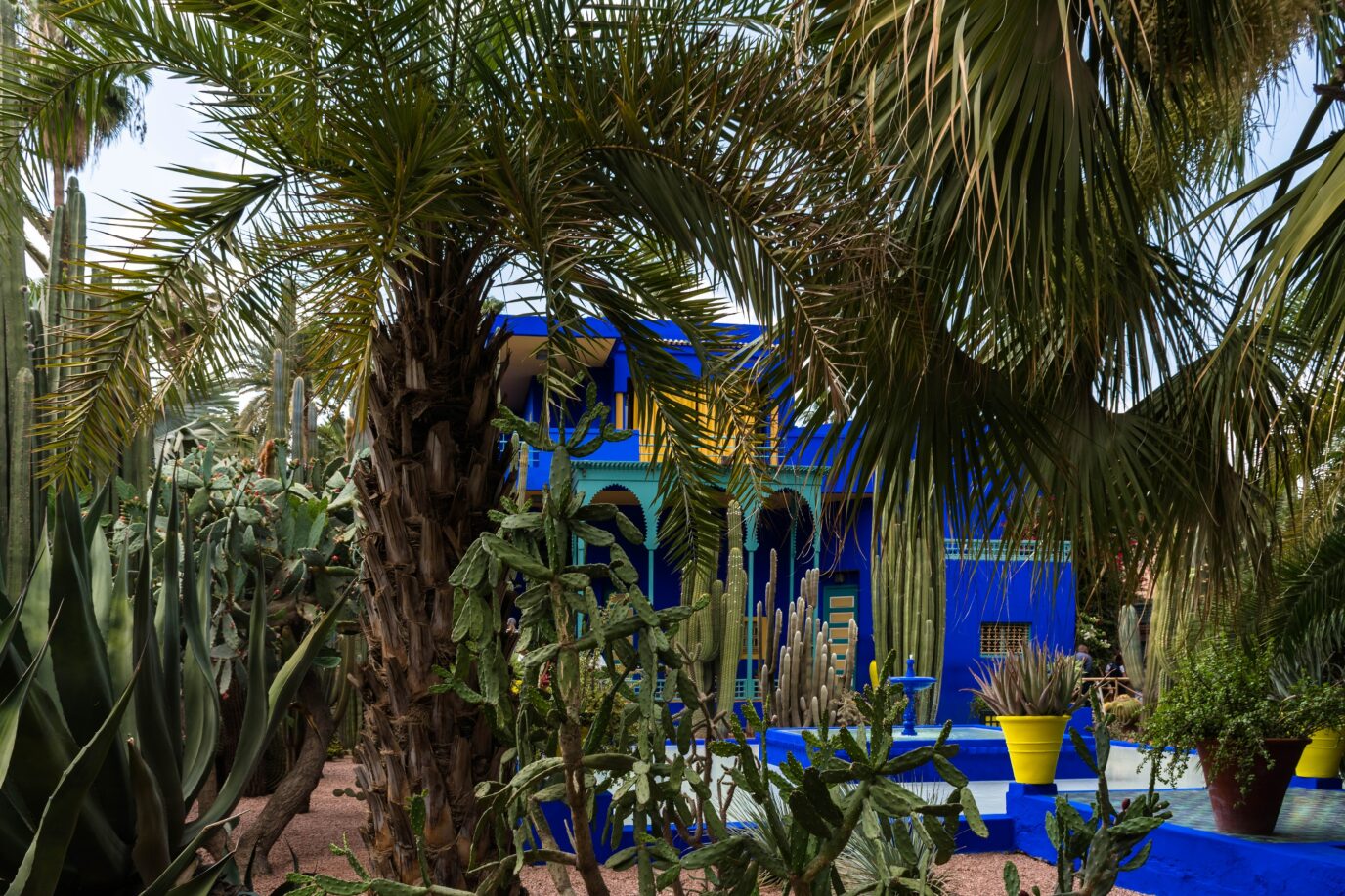Marrakech is a Makhzen city, much like Fez, Rabat, and Meknes, all of which are imperial cities. The successive dynasties that have resided there have contributed to its continual improvement. Additionally, it holds significant power as it lends its name to the entire country. Marrakech stands out as one of the most pivotal cultural hubs in all of Morocco. Serving as the epicenter of tourism, it is often the initial destination for travelers visiting Morocco. Renowned for its bustling markets, vibrant festivals, and myRiad attractions, Marrakech enjoys a well-deserved reputation as a dynamic and prominent city.
Marrakech
The Almoravid dynasty built Marrakech in 1062, and it quickly became one of the most important cities in Morocco. During the Almoravids’ and later the Almohads’ rule, it was a center for politics, culture, and trade. The city’s strategic position made it a key player in trade routes between Europe, sub-Saharan Africa, and the Middle East.
Marrakech has been home to many important landmarks and architectural wonders throughout its history. A few historical sites that show off the city’s rich history are the Koutoubia Mosque, the Bahia Palace, and the Saadian Tombs. During the Saadian dynasty (16th century), Marrakech thrived, becoming a symbol of wealth, art, and Islamic architecture.
Marrakech is still a lively city known for its busy streets, such as Jemaa el-Fnaa, colorful souks, and beautiful palaces. The city’s medieval medina, a UNESCO World Heritage site and one of Morocco’s most famous tourist spots, keeps the city’s history alive.
Why visit Marrakech?
People love to visit Marrakech because it has a lot of history, a lively atmosphere, and beautiful buildings. It is the center of Moroccan culture and has the right amount of old and new. You can walk through the medina and find narrow streets with bright souks where people sell their own crafts, textiles, and spices.
One of the city’s best features is Jemaa el-Fnaa, a lively square with street artists, storytellers, and tasty Moroccan food. The Koutoubia Mosque and the Bahia Palace are nearby historical places that showcase the city’s beautiful Islamic and Andalusian architecture.
Marrakech has traditional hammams, lush gardens like Jardin Majorelle, and fancy riads for people who want to rest. Every tourist will have an unforgettable experience in Marrakech, whether they walk around its lively streets or relax in a quiet retreat.
Top Attractions in Marrakech
The Koutoubia Mosque
The Koutoubia Mosque is one of the most important mosques in the Western Islamic world and the tallest building in Marrakech. Built by Abd al Mumin and completed by his son Yacoub El Mansour (1184-1189), it was named after a nearby book market, earning it the title “Mosque of Book Sellers.” While non-Muslims cannot enter, its towering minaret remains a landmark visible everywhere in the city.
Garden Menara
The Minzah pavilion, set against the snow-capped Atlas Mountains, is one of Marrakech’s most photographed spots. Built by the Almohads in the 12th century, the gardens feature olive groves and an artificial pond watered through underground channels from the Atlas Mountains. A peaceful escape for locals, they are about a 45-minute walk from the main square.
In the El Badi Palace, you can see a lot of
El Badi Palace, built by Sultan Ahmed al-Mansour in 1578, was once a symbol of luxury. Though now in ruins, its remaining walls and orange-filled courtyard offer stunning city views. The palace also serves as a backdrop for the annual Moroccan folklore festival.
The tombs of the Saadies
The Saadian Tombs, built by Sultan Ahmad al-Mansur in the 16th century, were rediscovered in 1917. They are one of the few remaining traces of the Saadian dynasty, which ruled from 1524 to 1659. Hidden behind high walls in the Kasbah neighborhood, the site features over 100 beautifully decorated tombs surrounded by a serene garden.
Medersa Ben Yousef
The Ben Youssef Madrasa in Marrakech is a historic Koranic school founded by the Merinid Sultan Abou el Hassan. It became the most important theological school in North Africa, attracting students from across the Muslim world. The madrasa features stunning stucco, mosaics, marble, and cedarwood, with a large central courtyard and beautifully decorated rooms that transport visitors back in time.
Jemaa el Fna square is where Jemaa lives
Jemaa el Fna Square is the center of life in Marrakech and shows how people live their daily lives. During the day, it’s full of people selling orange juice, putting on shows, and teasing snakes. When it gets dark, food stands open in the square, selling traditional Moroccan food. People can walk through it or watch from terraces close to take in the atmosphere. UNESCO has named it part of the “Oral and Intangible Heritage of Humanity,” making it an important place to learn about culture.
Bahia Palace
Bahia Palace, built in the late 19th century by Grand Vizier Ahmed ben Moussa, is a stunning architectural masterpiece near Jemaa el Fna. Moroccan architect Muhammad al-Mekki designed 160 rooms on a single floor and an 8-hectare garden. Legend says it was built for the vizier’s favorite concubine. The palace’s name, “the beautiful one,” reflects its elegance and charm.
Marrakesh walls
It is one of the things that make the city unique. The walls of Marrakech are made of adobe and have been kept up over the years. The sun’s rays and the weather affect their coloration. They protect the Medina’s secrets, a complex network of narrow streets, and are close to the nine-door old town.
The garden of the Majorelle House
It is in the new city, in the neighborhood of Guéliz, so it is in the town. This beautiful garden was made by the French painter Jacques Majorelle, and he made it (now its owner is Yves Saint-Laurent). Cacti, bamboos, bougainvillaea, and many other plants grow around a cobalt blue Art Deco chalet. Isn’t all: The gardens are known for having a lot of birds in them. Marrakech has a slew of additional attractions that are well worth a visit.
Mellah
The Mellah of Marrakech, built in 1559, was once Morocco’s most important Jewish quarter, housing 16,000 people until 1936. Since 1956, it has been predominantly inhabited by Muslims, with only about 300 Jews now living in Guéliz. Located near the Royal Palace for security, it was enclosed by walls with two gates, allowing controlled access to the Medina, which was guarded and closed at night. The name “Mellah” is believed to come from salt flats near the first Jewish quarter in Fez.
Almoravid Koubba
The Almoravid Koubba, built in the early 12th century by Ali Ben Youssef, is Morocco’s only remaining Almoravid structure. It highlights how the Almoravids supplied water to Marrakech. Due to rising ground levels, visitors must descend stairs to access it.
Where to Stay in Marrakesh
La Mamounia
A famous high-end hotel that blends the beauty of Morocco with modern conveniences, this hotel is known for its excellent service and beautiful design. It is set in a lovely yard.
Royal Mansour
This luxurious hotel was built by the King of Morocco. It has private riads with excellent service, gourmet food, and a luxurious experience in the middle of Marrakech.
Mandarin Oriental in Marrakech
It’s a peaceful place to stay, with large houses, private pools, and many gardens. It’s perfect for guests who want to relax and enjoy luxury in a tranquil setting.
Riad Yasmine
This lovely riad is famous for its peaceful courtyard pool and Instagram-worthy design. It is small, authentically Moroccan, and in a good spot.
Exploring the Culture of Marrakech
Local Culture: The culture of cities like Marrakech and Fez is based on customs that go back hundreds of years. The mix of Arab, Berber, and French styles produces a unique atmosphere that can be seen in the buildings, the language, and everyday life. People who live there are friendly and warm, and they value family and community life.
Food: Dishes like couscous, tagine, and pastilla are typical of Moroccan food. They are rich and delicious. Spices like cumin, saffron, and cinnamon are often used, and people like to eat grilled meats and fresh sweets on the street. Moroccan mint tea and sweet treats like baklava are essential to local food culture.
Music: Traditional Moroccan music includes styles like Andalusian, Berber, and Gnawa, which all come from different cultures. The rhythms and instruments, like the oud, darbuka, and violin, make tunes that are both lively and hypnotic. Music is very important during celebrations, festivals, and traditions. Dance and stories are often performed along with the music.
Clothes: Moroccan clothes are both useful and well-made. Men often wear the djellaba, an open robe, and women often wear the kaftan. Women also wear colorful scarves, especially in rural places. Traditional clothes are often made of wool or cotton and have lots of small needlework designs that show off the country’s culture.
Things to Do in Marrakech
Shopping in the Souks
The souks in Marrakech are famous for having a lively mood and selling many different goods. Moroccan rugs, leather goods, spices, pottery, and jewelry are just a few of the things you can find there. Shopping here isn’t just about getting things; it’s also about negotiating prices and getting to know the society.
A tour of the Medina
The Medina of Marrakech is a UNESCO World Heritage site that can be explored in many different ways. As you walk through its narrow streets, you can find secret courtyards, beautiful riads, and traditional buildings. It’s a fun way to learn about the city’s past and how it lives now.
Taste different foods at Jemaa el-Fna
If you like food, you have to go to Jemaa el-Fna Square. Food stands in the square selling everything from grilled meats and fresh juices to traditional Moroccan meals like tagine and couscous. It’s an excellent place for people who love food. It is one of the best places to enjoy authentic local food and a lively scene.
Entertainment at Jemaa el-Fna
In the evening, the square becomes busy with lots of fun things to do. Acrobats, storytellers, artists, snake charmers, and traditional dancers perform. It’s a great spot to see live performances of Moroccan culture and talk to both Moroccans and visitors.
Best Time to Visit Marrakech
Spring (March to May) and fall (September to November) are the best times to visit Marrakech. The weather is mild and pleasant during these times, with temperatures between 20°C and 25°C (68°F and 77°F). In this weather, you can enjoy the city’s sights and outdoor activities without dealing with summer or winter’s extreme heat or cold.
From June to August, temperatures can reach above 40°C (104°F), making it difficult to move around the city during the day.
Winter is cooler from December to February, but it’s still an excellent time for people who like warm weather. Temperatures range from 10°C to 20°C (50°F to 68°F). It can get cool at night, so it’s best to bring layers.
How to Get to Marrakech
Marrakech is easy to get to from many places worldwide using various transportation links.
By Air
A plane to Marrakesh Menara Airport (RAK) is the best way to get there. The airport is about 6 km from the city center and has trips both in and out of the country. Getting to big towns in Africa, the Middle East, and Europe is easy. You can hitch a ride or take a cab from the airport to the city center.
By Train
You can also take the train from towns in Morocco like Casablanca, Fez, and Rabat to Marrakech. The main train stop is the Gare de Marrakech, which is a short distance from the city center. The train system works well, is comfy, and gives you great views of Morocco.
By Bus
There are several bus lines that connect Marrakech to other Moroccan cities. The bus stop is close to the city center, and taking the bus is a cheaper way to get around.
By Car
You can also rent a car and drive to Marrakech if you’d rather. Some highways link the city to other big cities in Morocco. Remember that it can be hard to drive in Marrakech because the streets are small, there is a lot of traffic, and there aren’t many parking spots, especially in the Medina.

